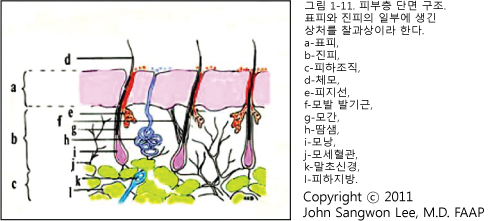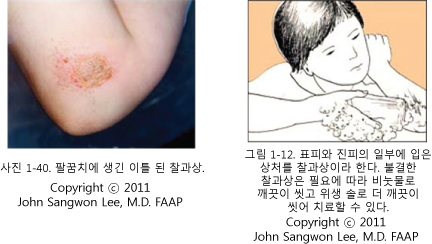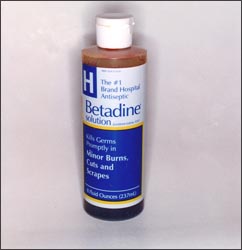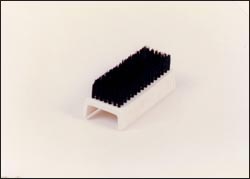좌상, 찰과상, Contusions, Abrasions(Scrapes)
좌상, 찰과상 개요
|
-
화상, 자상, 열상, 좌상과 찰과상 등의 사소한 외상이 소아청소년(0-18세) 자녀들에게 생기면, 대부분의 경우, 의사로부터 1차 최초치료를 받기 전에 부모 자신이 외상 사고가 생긴 현장에서 최초 단계 1차 응급처치를 우선 하는 것이 보통이다. 때로는 부모 자신이 필요에 따라 따라잡기 치료를 계속 하기도 한다.
-
또는 부모 자신이 사고 현장에서 최초 응급처치를 1차적으로 우선 한 다음 소아청소년과에서나 병원 응급실에서 따라 잡기 응급치료를 받는 것이 보통이다.
-
부모는 적어도 반의사가 되어야 소아청소년 자녀들에게 생긴 화상, 자상, 열상, 좌상과 찰과상 등을 사고 현장에서 1차 최초 응급처치를 적절히 할 수 있다.
-
소아청소년 자녀들에게 화상, 자상, 열상, 좌상과 찰과상 등 사소한 외상이 생길 때 사고가 난 현장에서 부모가 할 수 있는 최초 단계 급성 피부 손상 응급처치 (급성 피부 상처 응급 치료/Acute cutaneous wounds management) 방법에 관해 다음 설명한다.
-
대부분의 경우, 부모가 최초 처치를 사고 현장에서 해야 할 때가 많다.

좌상과 찰과상의 원인
-
피부 파손이 없는 피부 상해를 좌상 또는 타박상이라고 한다.
-
파손이 없이 뇌 실질에 생긴 손상을 뇌 좌상이라고 한다.
-
여기서는 피부에 생긴 좌상에 관해 주로 설명한다.
-
소아청소년들은 육체 활동력이 강하고 심하게 장난치고 육체적 운동도 많이 하기 때문에 좌상, 찰과상, 열상 등 각종 외상이 거의 매일 생기다시피 한다.
-
때로는 피부에 심한 좌상을 입을 수 있고 좌상과 찰과상을 동시 입을 수 있다.
-
피부의 일부를 어디에 심하게 스치거나 문질렸을 때 피부의 표피층이 얇게 벗겨지면서 피가 피부에 조금 맺히는 상처를 찰과상, 찰상, 또는 까진 상처(Abrasion)라고 한다.
-
찰과상은 넘어지거나 교통사고로 얼굴, 무릎, 팔다리, 몸통 등에 더 잘 생긴다.

좌상과 찰과상의 증상 징후
-
좌상 상처는 붓고 아프다. 좌상이 생긴 상처 부위의 기능이 제한될 수 있다. 하루 이틀이 지나면 붉어지고 멍이 든다.
-
찰과상의 중증도에 따라 증상 징후가 조금씩 다르다.
-
일반적으로 찰과상으로 생긴 피부 상처가 쓰리고 아프면서 조금 붓고, 진물이 조금 나면서 피가 맺히는 것이 보통이다.
-
찰과상을 입은 후 2~3일 지나면 찰과상 상처가 검푸르게 혹은 흑적색으로 멍든다.
-
적절히 치료해 주지 않으면 찰과상 상처에 세균이 감염되어 상처가 곪을 수 있다.
-
찰과상을 입었을 때 오물이 찰과상 상처가 있는 피부층이나 피하 조직 속으로 들어갈 수 있다.
좌상과 찰과상의 치료
-
좌상 상처를 입은 신체 부위가 아프거나 부으면 좌상 상처에 찬물찜질이나 얼음찜질을 바로 하면 덜 아프고 덜 부을 수 있다.
-
눌려서 생긴 압박 좌상이나 좌상 상처가 크거나 계속 아프고 부으면 의사의 지시에 따라 치료한다.
-
찰과상의 크기와 정도와 찰과상이 신체 어느 부위에 있느냐에 따라 조금 다르게 응급치료를 한다.
-
찰과상이 작고 비교적 깨끗할 때는 그대로 놓고 관찰 치료를 하든지 보통 비눗물이나 살균제 비눗물로 깨끗이 씻은 후 베타다인액 살균제로 살균 치료를 할 수 있다. 네오스포린 등 국소용 항생제 연고를 발라 치료 할 수 있다.
-
찰과상으로 생긴 상처가 불결하고 박테리아에 감염되었을 때는 살균제 비눗물로 오물을 깨끗이 씻는다.
-
상처에 도포용 항생제를 발아 치료 할 수 있다.
-
베타다인액 살균제에 알레르기가 생길 수 있다. 베타다인액 살균제로 치료하기 전에 베타다인액 살균제에 알레르기가 있나 알아봐야 한다.
-
베타다인액 살균제에 알레르기가 없으면 찰과상 상처를 비눗물로 씻지 않고 베타다인액 살균제로 씻고 일회용 밴드에이드로 상처를 덮어 치료 한다.

▴ 사진 1-41. 베타다인액 살균제는 미국에서 의사의 처방 없이
약국에서 사 가정 상비약으로 보관 했다가 쓸 수 있다.
Copyright ⓒ 2011 John Sangwon Lee, MD., FAAP
- 찰과상 상처의 크기와 정도에 따라 살균 치료를 해 찰과상을 치료하고 네오스포린 연고 등 도포용 항생제 연고를 상처에 바르고 일회용 밴드에이드나 무균 거즈로 찰과상을 덮어 치료할 수 있다.
-
찰과상 상처를 알코올로 살균 치료하는 응급치료는 권장하지 않는다.
-
작고 경미한 찰과상은 베타다인액 살균제로 살균치료 해 주면 잘 낫는다([부모도 반의사가 되어야 한다–소아가정간호백과]-제21권 소아청소년 가정 학교 간호–살균제 참조.)
-
먼지나 흙, 모래 등이 찰과상 상처의 표면에 묻혔거나 찰과상 상처에 깊이 박혔거나 찰과상에 오물이 묻어 불결하면 비눗물로 깨끗이 씻거나 깨끗한 거즈나 의료용 솔(사진 49 참조) 등으로 찰과상 상처에 묻어있는 먼지나 흙, 모래 등 오물을 조심스럽게 잘 씻어 치료 한다. 이렇게 치료 할 때 좀 아프고 상처에서 피가 조금 날 수 있다. 때로는 찰과상을 국소 마취를 하고 오물을 씻기도 한다.
-
불결한 찰과상은 비눗물로 깨끗이 씻은 후 베타다인액 살균제로 더 씻어 살균치료하기도 한다. 그리고 찰과상을 무균 거즈로 덮고 그 위에 붕대를 감아 고정시키거나 반창고로 고정시킬 수 있다.
-
찰과상 상처에서 난 진물이 다 마르고 곪지 않았을 때는 덮었던 거즈를 뗀다. 필요에 따라 새 거즈로 갈아준다. 의사의 지시에 따라 파상풍 백신 예방접종을 받는다.

▴ 사진 1-41. 필요에 따라 깨끗한 물로 찰과상 상처에 묻은 오물을 깨끗이 씻고
때로는 위생용 솔로 더 깨끗이 씻을 수 있다.
Copyright ⓒ 2011 John Sangwon Lee, MD., FAAP
- 좌상 상처가 화끈거리면서 아플 때는 타이레놀 등 진통제로 진통시킨다.
-
찰과상 상처가 곪거나 모래나 나뭇조각 등의 이물이 찰과상 상처 속 깊이 들어가 있을 때는 병원에서 이물을 적절히 제거한다.
-
상처를 덮었던 거즈나 일회용 밴드에이드 등을 1~2일마다 새 것으로 바꾼다.
-
거즈 등을 갈아줄 때마다 곪지 않도록 피부 도포용 네오스포린 항생제 연고나, 배시트라신 항생제 연고 또는 백트로반 항생제 연고를 발라 치료하든지 베타다인액 살균제로 다시 살균치료 한다.
-
찰과상 상처가 크거나 불결하거나 집에서 치료할 자신이 없을 때는 의사에게 문의해서 적절한 치료를 받아야 한다.
-
찰과상 상처가 곪았을 때는 경구용 항생제나 혈관용 항생제 등으로 적절히 치료한다.
-
찰과상 상처가 전 피부층에 생기고 너비가 1㎠ 보다 더 크거나 찰과상을 입은 후 2주 내 낫지 않으면 성형외과의 치료를 받도록 권장한다(출처; NEJM September 2008 p.1037).
|
다음은 “눈 부근에 상처, 찰과상,”에 관한 인터넷 소아청소년 건강상담 질의응답의 예 입니다. |
Q&A. 눈 부근 상처, 찰과상,
Q.
안녕하세요. 지난번 답변 감사드립니다. 9개월 여아인데요. 눈 가까이에, 아래 눈꺼풀 바로 아래에 긁힌 상처가 생겼습니다. 눈을 비비다가 그런 모양이에요. 항상 손톱을 짧게 깎아주는데도.. 어떤 약을 발라야 되는지요? 졸릴 때마다 비벼대고 또 눈물 등으로 인해 자주 젖어 있는 부분이라서 잘 안 낫는데다 혹 감염이 될까봐서요. 베타다인액 살균제나 네오스포린이 있긴 한데 눈에 들어갈 것 같아서 안 발라주고 있습니다.
눈 주위에 발라주어도 되는 약이 있으면 알려 주세요
A.
엄지 어머님
안녕하세요. 질문해 주셔서 감사합니다. 좋은 질문입니다. 자녀의 나이, 성별, 과거 병력, 가족 병력, 진찰소견, 임상검사 등의 정보를 많이 알수록 답변을 드리는데 도움이 됩니다. 주신 정보를 토대로 해서 답변을 드리겠습니다.
베타다인액 살균제 등의 피부 살균제를 Q팁에 조금 묻혀서 환부에 살짝 발라주고 1~2분 동안 기다리면 발라준 살균제의 일부는 피부를 통해 핏 속으로 흡수될 수 있을 것입니다.
극소량의 베타다인액 살균제가 여아 자녀의 눈으로 들어가면 눈에서 눈물이 나와 베타다인액 살균제가 희석되고 눈물로 씻겨 나옵니다.
베타다인액 살균제로 살균치료를 해도 크게 걱정할 필요는 없습니다.
베타다인액 살균제로 인해서 알레르기가 생길 수 있으므로 주의해서 써야 합니다.
네오스포린 항생제 연고로 치료할 수 있습니다.
치료를 시작 하기 전에 사용법을 자세히 읽어보시기 바랍니다.
[부모도 반의사가 되어야 한다–소아가정간호]-제21권 소아청소년 가정 학교간호–가정간호용 살균제 등을 참조하십시오.
질문이 더 있으면 다시 연락해 주시기 바랍니다.
감사합니다. 새해에 건강하시고 복을 많이 받으시고 모든 일이 형통하시기 빕니다. 이상원 드림
Contusions, Abrasions(Scrapes) 좌상, 찰과상
좌상, 찰과상 개요
|
- If minor trauma such as burns, cuts, lacerations, cuts, and abrasions occurs on children and adolescents (0-18 years old),
- In most cases, parents themselves are the first step at the site of the trauma accident before receiving the first initial treatment from a doctor.
- It is common to give priority to first aid.
- Sometimes parents themselves continue to perform catch-up treatment as needed. Or,
- it is common for the parents themselves to give priority to first aid at the accident site, and then receive catch-up emergency treatment at the pediatrics department or at the hospital emergency room.
- Parents must be at least half -doctors in order to appropriately take the first aid at the accident site for burns, cuts, lacerations, cuts, and abrasions that occurred to children and young children.
- When minor traumas such as burns, cuts, lacerations, cuts, and abrasions occur to children and adolescents, the first step that parents can do at the site of the accident, first-aid measures for acute skin damage (acute cutaneous wounds management)
- The following will be explained. In most cases, parents often have to do the first treatment at the accident site.

Causes of contusions and abrasions
- Skin injuries without skin breakage are called contusion or bruises.
- Damage to the brain parenchyma without breakage is called brain contusion.
- Here, we mainly describe the contusion on the skin.
- Children and adolescents have strong physical activity, play badly, and do a lot of physical exercises, so various traumas such as contusions, abrasions, and lacerations occur almost every day.
- Sometimes, the skin may suffer severe contusions, and both strains and abrasions can occur at the same time.
- When a part of the skin is severely contusions or rubbed, the epidermal layer of the skin is thinly peeled off and a small amount of blood is formed on the skin is called abrasion.
- Abrasions are more common on the face, knees, limbs, and torso due to a fall or a traffic accident.

Symptoms of contusions and abrasion
- The upper wound is swollen and painful.
- The function of the wound area where the abrasion has occurred may be limited.
- After a day or two, it turns red and bruises.
- Symptoms, signs vary slightly depending on the severity of the abrasion.
- In general, skin wounds caused by abrasions are sore and painful, and a little swelling and a little swelling and blood formation are common.
- ‘After 2-3 days of abrasion, the abrasion wound is bruised black or red.
- If not treated properly, the contusion and abrasion wound can become infected with bacteria and fester the wound.
- In the event of abrasion, dirt can enter the skin layer or subcutaneous tissue where the abrasion wound is located.
Treatment of the contusion and abrasion
- If the affected part of the body hurts or is swollen, applying cold water or ice to the left wound right away can make it less painful and less swollen.
- If the compression wound or left wound caused by pressure is large or continues to be painful and swollen, treat it according to the doctor’s instructions.
- Emergency treatment is given a little differently depending on the size and extent of the abrasion and where the abrasion is located on the body.
- When the abrasion is small and relatively clean, it can be left as it is for observational treatment, or after washing with soapy water or a disinfectant soapy water, sterilization treatment can be performed with such as betadine solution disinfectant.
- It can be treated by applying a topical antibiotic ointment such as Neosporin.
- If the abrasion wound is dirty and infected with bacteria, wash the dirt thoroughly with soap and water with a disinfectant.
- Antibiotics for application to wounds can be used to treat infections.
- You may be allergic to betadine solution disinfectants.
- Before treating with betadine solution disinfectant, you should find out if your child is allergic to betadine solution disinfectant.
- If your child is not allergic to betadine liquid disinfectant, the abrasion wound should not be washed with soapy water but washed with betadine liquid disinfectant, and the wound covered with a disposable band-aid should be treated.

▴ Photo 1-41. Betadine solution disinfectant is used in the United States without a doctor’s prescription. It can be stored and used as a household medicine at a pharmacy. Copyright ⓒ 2011 John Sangwon Lee, MD., FAAP
- Depending on the size and extent of the abrasion wound, sterilization treatment is performed to treat the abrasion, and an antibiotic ointment for application such as Neosporin ointment is applied to the wound, and the abrasion can be treated by covering the abrasion with a disposable band-aid or sterile gauze.
- We do not recommend emergency treatment of abrasion wounds with alcohol sterilization.
- Small and minor abrasions can be healed by sterilization treatment with a betadine solution disinfectant
- ([Parents must also be at least the half–doctors-Encyclopedia of Pediatrics and Family Nursing)-Volume 21 Children and Adolescents Home School Nursing-Disinfectants.)
- If dust, dirt, sand, etc. is buried on the surface of the abrasion wound, or if it is deeply embedded in the abrasion wound, or is dirty due to dirt on the abrasion, wash it thoroughly with soapy water or dust on the abrasion wound with clean gauze or medical brush (refer to Photo 49) B.
- Wash and treat dirt, sand, and other dirt carefully.
- When treated like this, it hurts a little and the wound may bleed a little.
- Sometimes, local anesthesia for the abrasion is performed and the dirt is washed away.
- Unclean abrasions are washed with soapy water, and then washed further with betadine disinfectant and sterilized.
- Then, the abrasion can be covered with sterile gauze and fixed with a bandage or band-aid.
- When the skin from the abrasion wound is dry and not infected, remove the covered gauze.
- Change with new gauze as needed.
- Get the tetanus vaccine as directed by your doctor.

▴ Photo 1-41. If necessary, wash the dirt off the abrasion wound with clean water. Sometimes you can wash it more thoroughly with a hygiene brush.
Copyright ⓒ 2011 John Sangwon Lee, MD., FAAP
- When the wound is hot and painful, pain relievers such as Tylenol are used.
- If the abrasion wound is infected or a foreign object such as sand or wood is deep inside the abrasion wound, the foreign body should be properly removed at the hospital.
- Replace the wound covered with gauze or disposable band-aids with new ones every 1-2 days.
- Whenever changing gauze, etc., either Neosporin antibiotic ointment for skin application, bacitracin antibiotic ointment, or Bactroban antibiotic ointment is applied to prevent festering, or re-sterilization treatment with betadine solution disinfectant.
- If the abrasion wound is large or dirty or if you are unsure of what to do at home, you should consult your doctor for appropriate treatment.
- When the abrasion wound is infected, it is appropriately treated with oral antibiotics or intravenous antibiotics.
- If the abrasion wound occurs on the entire skin layer and the width is greater than 1㎠ or does not heal within 2 weeks after the abrasion, it is recommended to seek treatment by a plastic surgeon (source; NEJM September 2008 p.1037).
The following is an example of the Internet pediatric and adolescent health counseling question and answer about “wounds near the eyes, abrasions,”
. Q&A.
- Wounds near the eyes, abrasions,
- Thank you for the last reply.
- I have a 9-month girl.
- A scratch has occurred near the eyes and just under the lower eyelid.
- It looks like that when she rubs your eyes.
- I always cut my nails short..
- What kind of medicine should I use?
- Whenever I get sleepy, I rub it and it’s often wet due to tears, so it doesn’t heal well, and I’m afraid it might get infected.
- There are betadine liquid disinfectants or Neosporin, but I don’t apply them because they seem to get into my eyes.
- Please let me know if there are any medicines that can be applied around the eyes.
- Dear mother Hello. Thanks for asking. That’s a good question. The more information you know about your child’s age, gender, past medical history, family medical history, medical examination findings, and clinical examination, the more helpful it is to give you an answer.
- We will respond based on the information you provided.
- Apply a little bit of skin disinfectant such as betadine solution disinfectant to the Q tip and apply it lightly to the affected area, and wait for 1 to 2 minutes so that some of the applied disinfectants may be absorbed into the blood through the skin.
- When a very small amount of betadine disinfectant enters the eyes of a girl’s child, tears come out of the eyes, and the betadine disinfectant is diluted and washed away with tears.
- Even if you perform sterilization treatment with betadine solution disinfectant, there is no need to worry too much.
- Betadine solution disinfectant may cause allergies, so it should be used with care. It can be treated with Neosporin antibiotic ointment.
- Please read the instructions carefully before starting treatment.
- Refer to [Parents should also be at least the half-doctors-Child and Family Nursing]-Volume 21 Children and Adolescents, Home School Nursing, and Disinfectants for Home Nursing.
- If you have more questions, please contact us again.
- Thank you.
- May you be healthy and blessed in the new year, and all things prosper.
- Lee Sang-won ., MD
출처 및 참조 문헌 Sources and references
- NelsonTextbook of Pediatrics 22ND Ed
- The Harriet Lane Handbook 22ND Ed
- Growth and development of the children
- Red Book 32nd Ed 2021-2024
- Neonatal Resuscitation, American Academy Pediatrics
-
Childhood Emergencies in the Office, Hospital and Community, American Academy of Pediatrics
-
Emergency Medical Service for Children, By Ross Lab. May 1989. p.10
-
Emergency care, Harvey grant and Robert Murray
-
Emergency Care Transportation of Sick and Injured American Academy of Orthopaedic Surgeons
-
Emergency Pediatrics A Guide to Ambulatory Care, Roger M. Barkin, Peter Rosen
-
Immediate care of the acutely ill and injured, Hugh E. Stephenson, Jr
-
The Critically Ill Child, Diagnosis and Management, Edited by Clement A. Smith
-
Emergency Medical Services for Children: The Role of the Primary Care Provider, America Academy of Pediatrics
-
Quick Reference To Pediatric Emergencies, Delmer J. Pascoe, M.D., Moses Grossman, M.D. with 26 contributors
-
Manual of Emergency Care 응급환자관리 정담미디어
-
소아가정간호백과–부모도 반의사가 되어야 한다, 이상원
-
Neonatal Resuscitation American heart Association
-
Neonatology Jeffrey J.Pomerance, C. Joan Richardson
-
Pediatric Resuscitation Pediatric Clinics of North America, Stephen M. Schexnayder, M.D.
-
Pediatric Critical Care, Pediatric Clinics of North America, James P. Orlowski, M.D.
-
Preparation for Birth. Beverly Savage and Dianna Smith
-
Nelson Textbook of Pediatrics 14th ed. Beherman,
-
The Johns Hopkins Hospital, The Harriet Lane Handbook, 18th edition
-
Red book 29th-31st edition 2021
-
Nelson Text Book of Pediatrics 19th-21st Edition
-
Infectious disease of children, Saul Krugman, Samuel L Katz, Ann A. Gershon, Catherine Wilfert
-
The Harriet Lane Handbook 19th-21st Edition
-
소아과학 안효섭 외 대한교과서
-
제1권 소아청소년 응급의료 참조문헌과 출처
-
Other
Copyright ⓒ 2015 John Sangwon Lee, MD., FAAP
“부모도 반의사가 되어야 한다”-내용은 여러분들의 의사로부터 얻은 정보와 진료를 대신할 수 없습니다.
“The information contained in this publication should not be used as a substitute for the medical care and advice of your doctor. There may be variations in treatment that your doctor may recommend based on individual facts and circumstances. “Parental education is the best medicine.”